Marketing Plan: Air New Zealand's Airbus A320 Fleet and Strategy
VerifiedAdded on 2020/05/08
|17
|4488
|93
Report
AI Summary
This report presents a comprehensive marketing plan for Air New Zealand, focusing on the Airbus A320 fleet and its role in addressing challenges within the New Zealand aviation industry. The plan begins with an executive summary and introduction, followed by a detailed situational analysis, including political, economic, socio-cultural, technological, and legal forces (PESTL analysis), and a competitor analysis. A customer analysis is also included. A SWOT analysis identifies the airline's strengths, weaknesses, opportunities, and threats. The report outlines specific, measurable, achievable, relevant, and time-bound (SMART) marketing objectives, target market identification, and market segmentation. The marketing mix strategy, including product, price, place, and promotion, is detailed, alongside a budget and implementation plan. The report concludes with an evaluation, recommendations, and references, aiming to provide actionable strategies for Air New Zealand to enhance its market position and address operational issues, such as those related to its economy flights and short routes. The report emphasizes the importance of a contingency plan for unforeseen circumstances.
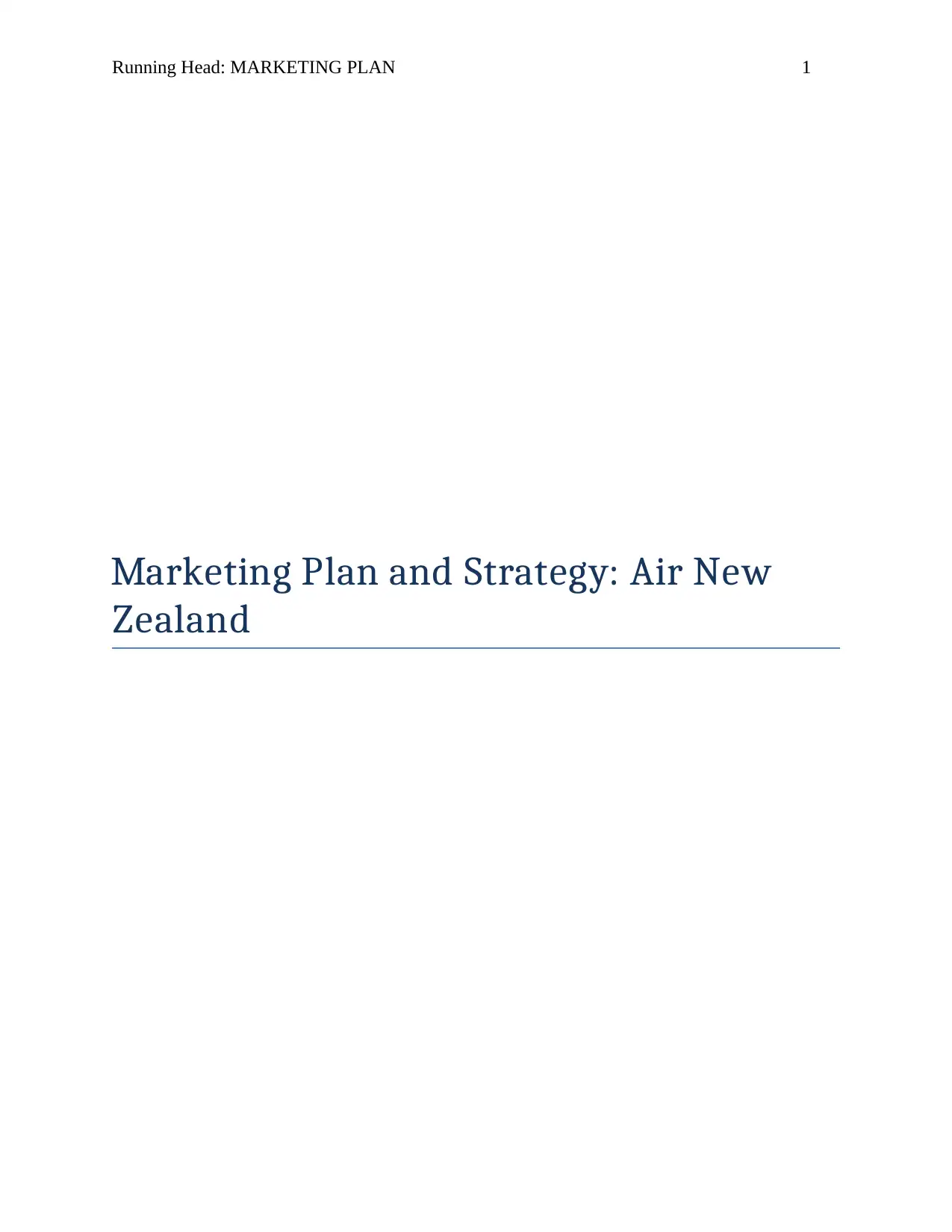
Running Head: MARKETING PLAN 1
Marketing Plan and Strategy: Air New
Zealand
Marketing Plan and Strategy: Air New
Zealand
Paraphrase This Document
Need a fresh take? Get an instant paraphrase of this document with our AI Paraphraser
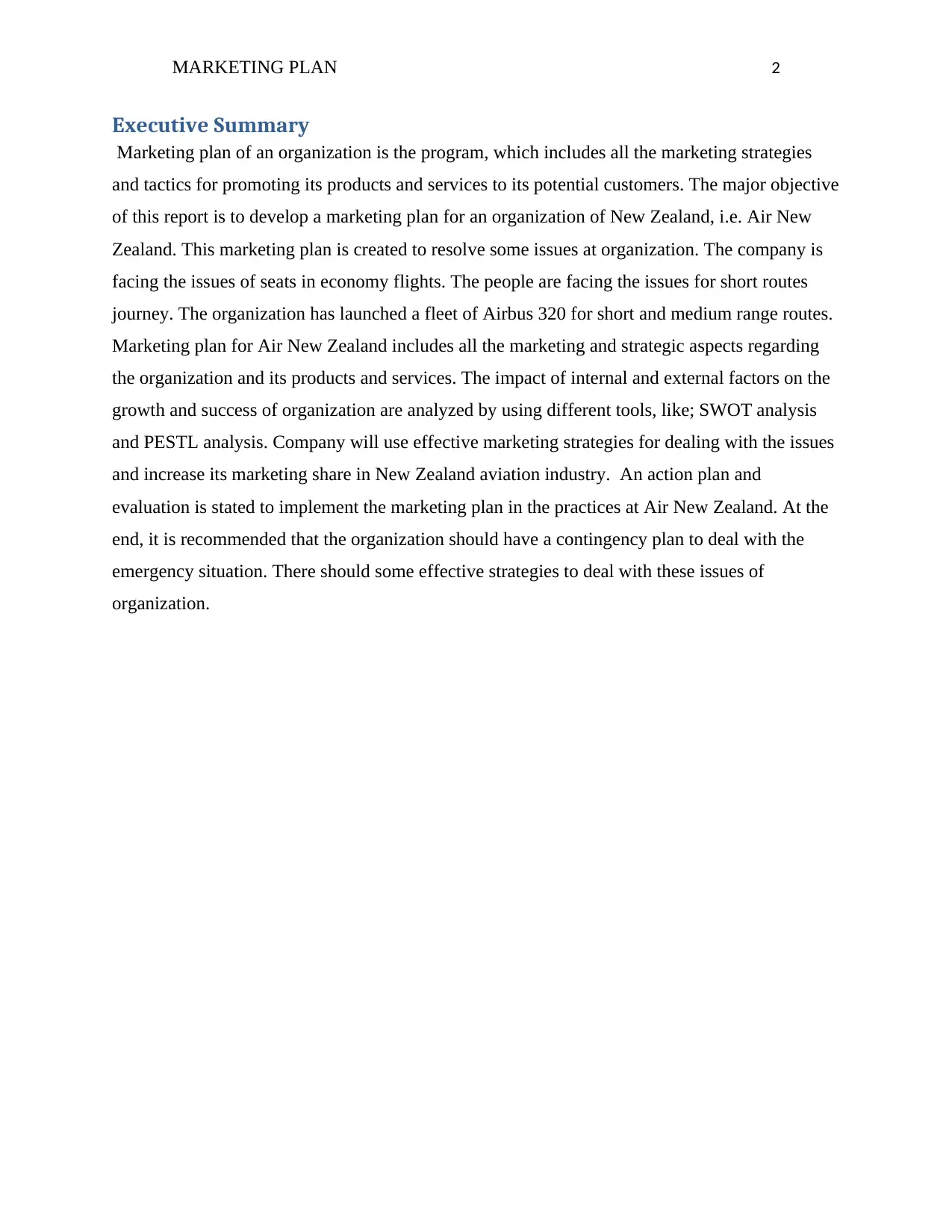
MARKETING PLAN 2
Executive Summary
Marketing plan of an organization is the program, which includes all the marketing strategies
and tactics for promoting its products and services to its potential customers. The major objective
of this report is to develop a marketing plan for an organization of New Zealand, i.e. Air New
Zealand. This marketing plan is created to resolve some issues at organization. The company is
facing the issues of seats in economy flights. The people are facing the issues for short routes
journey. The organization has launched a fleet of Airbus 320 for short and medium range routes.
Marketing plan for Air New Zealand includes all the marketing and strategic aspects regarding
the organization and its products and services. The impact of internal and external factors on the
growth and success of organization are analyzed by using different tools, like; SWOT analysis
and PESTL analysis. Company will use effective marketing strategies for dealing with the issues
and increase its marketing share in New Zealand aviation industry. An action plan and
evaluation is stated to implement the marketing plan in the practices at Air New Zealand. At the
end, it is recommended that the organization should have a contingency plan to deal with the
emergency situation. There should some effective strategies to deal with these issues of
organization.
Executive Summary
Marketing plan of an organization is the program, which includes all the marketing strategies
and tactics for promoting its products and services to its potential customers. The major objective
of this report is to develop a marketing plan for an organization of New Zealand, i.e. Air New
Zealand. This marketing plan is created to resolve some issues at organization. The company is
facing the issues of seats in economy flights. The people are facing the issues for short routes
journey. The organization has launched a fleet of Airbus 320 for short and medium range routes.
Marketing plan for Air New Zealand includes all the marketing and strategic aspects regarding
the organization and its products and services. The impact of internal and external factors on the
growth and success of organization are analyzed by using different tools, like; SWOT analysis
and PESTL analysis. Company will use effective marketing strategies for dealing with the issues
and increase its marketing share in New Zealand aviation industry. An action plan and
evaluation is stated to implement the marketing plan in the practices at Air New Zealand. At the
end, it is recommended that the organization should have a contingency plan to deal with the
emergency situation. There should some effective strategies to deal with these issues of
organization.

MARKETING PLAN 3
Table of Contents
Executive Summary.........................................................................................................................2
Introduction......................................................................................................................................4
Situational Analysis.........................................................................................................................5
Political Forces.............................................................................................................................6
Economic Forces..........................................................................................................................6
Socio-cultural Forces...................................................................................................................6
Technological Forces...................................................................................................................7
Legal Forces.................................................................................................................................7
Competitor Analysis........................................................................................................................7
Customer Analysis...........................................................................................................................7
SWOT Analysis...............................................................................................................................8
Strengths.......................................................................................................................................8
Weaknesses..................................................................................................................................8
Opportunities................................................................................................................................8
Threats..........................................................................................................................................9
Marketing Objectives.......................................................................................................................9
SMART Analysis.............................................................................................................................9
Specific.........................................................................................................................................9
Measurable.................................................................................................................................10
Achievable.................................................................................................................................10
Relevant.....................................................................................................................................10
Time-bound................................................................................................................................10
Target Market.............................................................................................................................10
Market Segmentation.................................................................................................................11
Marketing Mix Strategy.................................................................................................................11
Product.......................................................................................................................................11
Price...........................................................................................................................................12
Place...........................................................................................................................................12
Table of Contents
Executive Summary.........................................................................................................................2
Introduction......................................................................................................................................4
Situational Analysis.........................................................................................................................5
Political Forces.............................................................................................................................6
Economic Forces..........................................................................................................................6
Socio-cultural Forces...................................................................................................................6
Technological Forces...................................................................................................................7
Legal Forces.................................................................................................................................7
Competitor Analysis........................................................................................................................7
Customer Analysis...........................................................................................................................7
SWOT Analysis...............................................................................................................................8
Strengths.......................................................................................................................................8
Weaknesses..................................................................................................................................8
Opportunities................................................................................................................................8
Threats..........................................................................................................................................9
Marketing Objectives.......................................................................................................................9
SMART Analysis.............................................................................................................................9
Specific.........................................................................................................................................9
Measurable.................................................................................................................................10
Achievable.................................................................................................................................10
Relevant.....................................................................................................................................10
Time-bound................................................................................................................................10
Target Market.............................................................................................................................10
Market Segmentation.................................................................................................................11
Marketing Mix Strategy.................................................................................................................11
Product.......................................................................................................................................11
Price...........................................................................................................................................12
Place...........................................................................................................................................12
⊘ This is a preview!⊘
Do you want full access?
Subscribe today to unlock all pages.

Trusted by 1+ million students worldwide
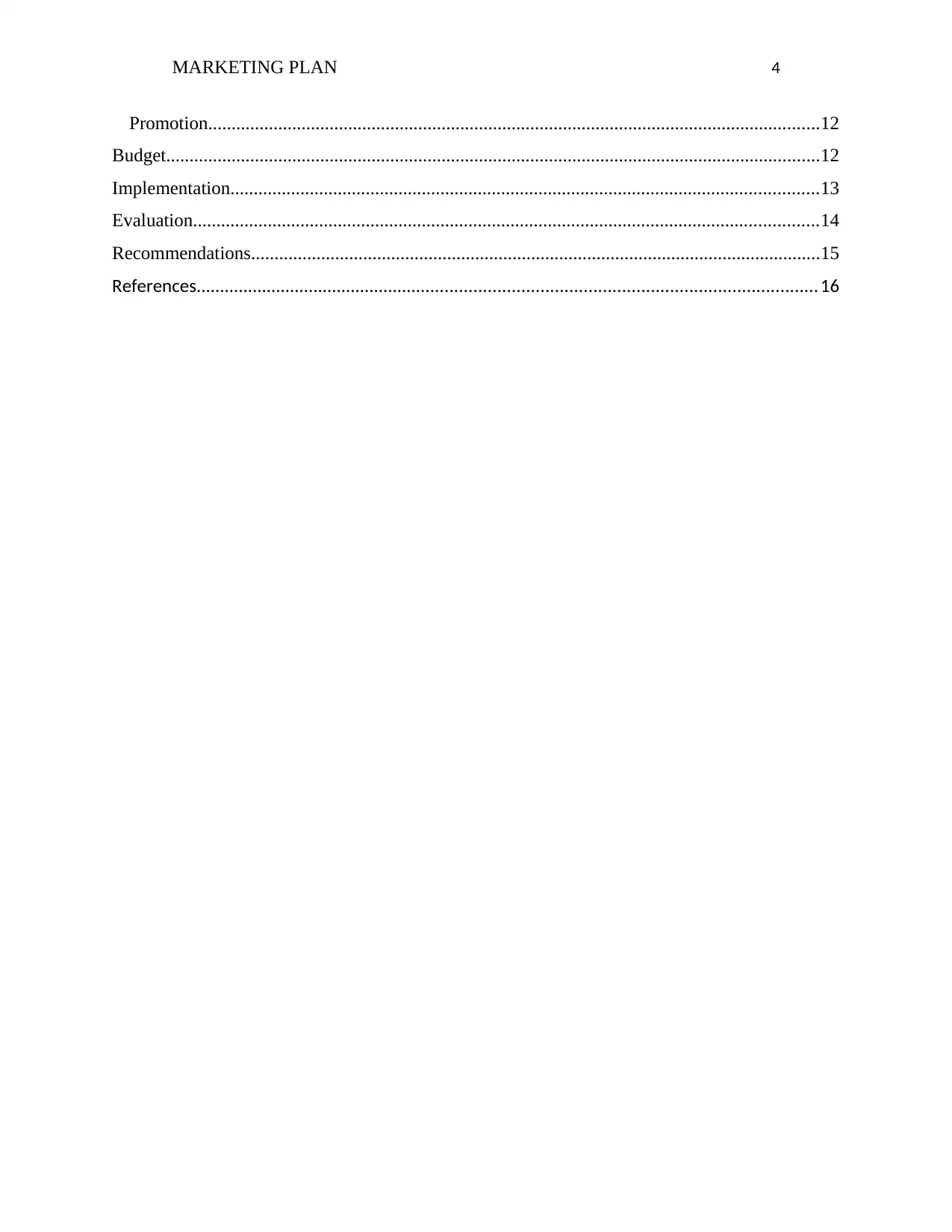
MARKETING PLAN 4
Promotion...................................................................................................................................12
Budget............................................................................................................................................12
Implementation..............................................................................................................................13
Evaluation......................................................................................................................................14
Recommendations..........................................................................................................................15
References................................................................................................................................... 16
Promotion...................................................................................................................................12
Budget............................................................................................................................................12
Implementation..............................................................................................................................13
Evaluation......................................................................................................................................14
Recommendations..........................................................................................................................15
References................................................................................................................................... 16
Paraphrase This Document
Need a fresh take? Get an instant paraphrase of this document with our AI Paraphraser

MARKETING PLAN 5
Introduction
Marketing plan of an organization is an important document of organization that includes various
strategic aspects, which it can use for bringing its products and services to marketplace. This
plan of company includes all the significant information about its products and services. Each
and every organization needs to develop a marketing plan to promote its products and services in
the existing and new marketplace. The organization, which is taken into consideration here, is
Air New Zealand. Air New Zealand Limited is a New Zealand based airline and it is a flag
carrier. The airline is based in Auckland and operating scheduled passenger flights to more than
30 international and over 20 domestic destinations in 19 nations around United Kingdom and
Pacific rim.
In the year 1940, the company was established as Tasman Empire Airways Limited (TEAL),
which was running trans-Tasman airlifts between Australia and New Zealand. After some years
in 1965, TEAL was renamed as Air New Zealand that is wholly owned by New Zealand
Government. It is headquartered in Wynyard Quarter, Auckland City in New Zealand. Currently,
it operates a fleet of Boeing 777, Airbus A320, and Boeing 787 aircraft. According to the recent
facts and figures, more than 12.8 million travellers are carried yearly by Air New Zealand (Air
New Zealand Limited, 2017). The company operates its business locally with its domestic
subsidiaries, like; Eagle Airways, Air Nelson, Mount Cook Airline etc. Till June 206, the number
of employees, employed by company is 10,527. According to the report 2016, the revenues of
company are NZ$5,231 million and profit of NZ$463 million. In the year 2014, JACDEC has
ranked Air New Zealand as safest airline in the world. This report is focused on its product, i.e.
Airbus A320 plane, which is the smallest international configuration of Air New Zealand. It is
serving shorter international routes and trans-Tasmanian routes. Under this product of the
company, the company has designed with specific features and well-designed seats.
Situational Analysis
Before creating marketing strategy, it is significant to perform a situational analysis. Situational
analysis is very important part of a marketing plan and it should be reviewed in a certain period.
Situational Analysis is a tool that includes the internal and external factors of an organization and
it analyses different external factors, which impact the growth and success of the organization in
Introduction
Marketing plan of an organization is an important document of organization that includes various
strategic aspects, which it can use for bringing its products and services to marketplace. This
plan of company includes all the significant information about its products and services. Each
and every organization needs to develop a marketing plan to promote its products and services in
the existing and new marketplace. The organization, which is taken into consideration here, is
Air New Zealand. Air New Zealand Limited is a New Zealand based airline and it is a flag
carrier. The airline is based in Auckland and operating scheduled passenger flights to more than
30 international and over 20 domestic destinations in 19 nations around United Kingdom and
Pacific rim.
In the year 1940, the company was established as Tasman Empire Airways Limited (TEAL),
which was running trans-Tasman airlifts between Australia and New Zealand. After some years
in 1965, TEAL was renamed as Air New Zealand that is wholly owned by New Zealand
Government. It is headquartered in Wynyard Quarter, Auckland City in New Zealand. Currently,
it operates a fleet of Boeing 777, Airbus A320, and Boeing 787 aircraft. According to the recent
facts and figures, more than 12.8 million travellers are carried yearly by Air New Zealand (Air
New Zealand Limited, 2017). The company operates its business locally with its domestic
subsidiaries, like; Eagle Airways, Air Nelson, Mount Cook Airline etc. Till June 206, the number
of employees, employed by company is 10,527. According to the report 2016, the revenues of
company are NZ$5,231 million and profit of NZ$463 million. In the year 2014, JACDEC has
ranked Air New Zealand as safest airline in the world. This report is focused on its product, i.e.
Airbus A320 plane, which is the smallest international configuration of Air New Zealand. It is
serving shorter international routes and trans-Tasmanian routes. Under this product of the
company, the company has designed with specific features and well-designed seats.
Situational Analysis
Before creating marketing strategy, it is significant to perform a situational analysis. Situational
analysis is very important part of a marketing plan and it should be reviewed in a certain period.
Situational Analysis is a tool that includes the internal and external factors of an organization and
it analyses different external factors, which impact the growth and success of the organization in
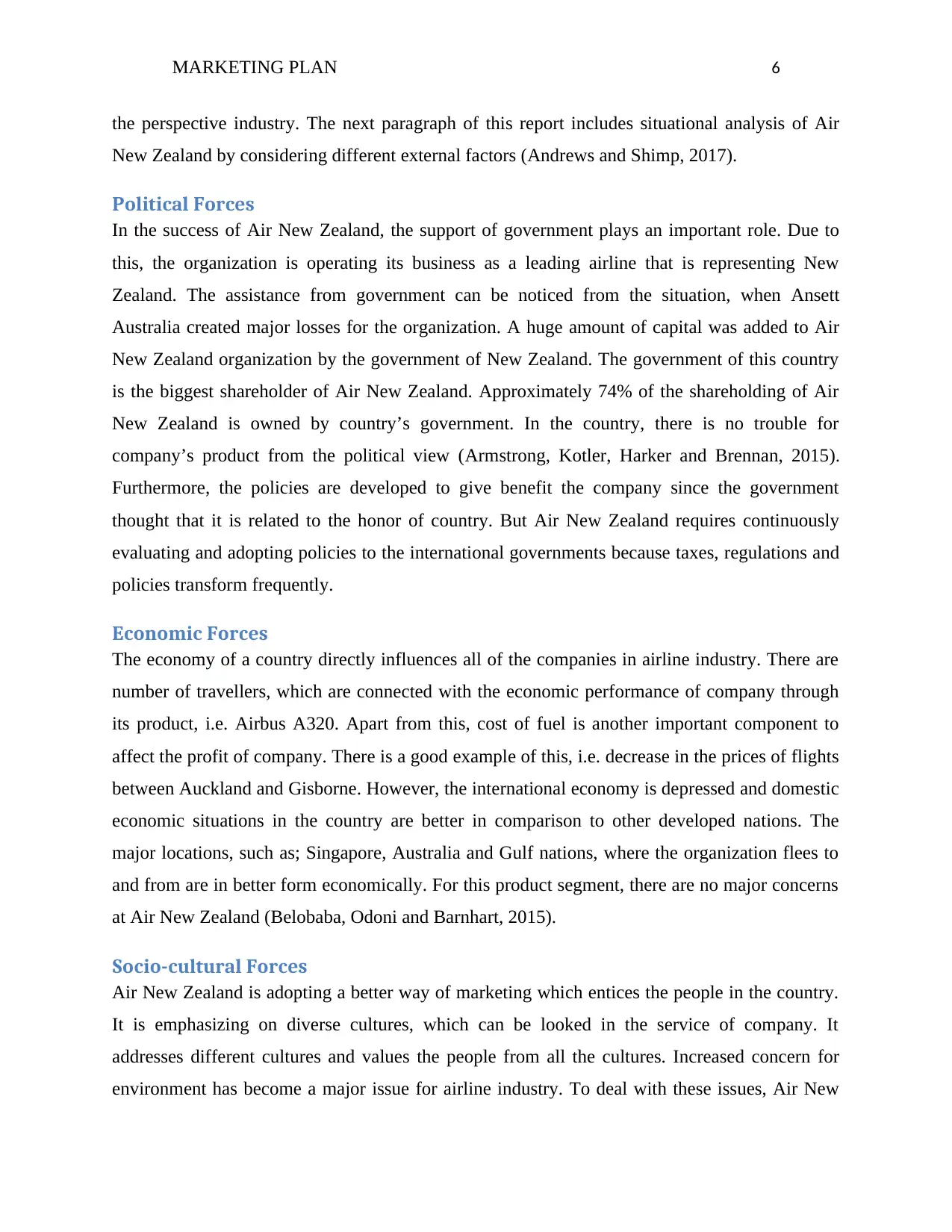
MARKETING PLAN 6
the perspective industry. The next paragraph of this report includes situational analysis of Air
New Zealand by considering different external factors (Andrews and Shimp, 2017).
Political Forces
In the success of Air New Zealand, the support of government plays an important role. Due to
this, the organization is operating its business as a leading airline that is representing New
Zealand. The assistance from government can be noticed from the situation, when Ansett
Australia created major losses for the organization. A huge amount of capital was added to Air
New Zealand organization by the government of New Zealand. The government of this country
is the biggest shareholder of Air New Zealand. Approximately 74% of the shareholding of Air
New Zealand is owned by country’s government. In the country, there is no trouble for
company’s product from the political view (Armstrong, Kotler, Harker and Brennan, 2015).
Furthermore, the policies are developed to give benefit the company since the government
thought that it is related to the honor of country. But Air New Zealand requires continuously
evaluating and adopting policies to the international governments because taxes, regulations and
policies transform frequently.
Economic Forces
The economy of a country directly influences all of the companies in airline industry. There are
number of travellers, which are connected with the economic performance of company through
its product, i.e. Airbus A320. Apart from this, cost of fuel is another important component to
affect the profit of company. There is a good example of this, i.e. decrease in the prices of flights
between Auckland and Gisborne. However, the international economy is depressed and domestic
economic situations in the country are better in comparison to other developed nations. The
major locations, such as; Singapore, Australia and Gulf nations, where the organization flees to
and from are in better form economically. For this product segment, there are no major concerns
at Air New Zealand (Belobaba, Odoni and Barnhart, 2015).
Socio-cultural Forces
Air New Zealand is adopting a better way of marketing which entices the people in the country.
It is emphasizing on diverse cultures, which can be looked in the service of company. It
addresses different cultures and values the people from all the cultures. Increased concern for
environment has become a major issue for airline industry. To deal with these issues, Air New
the perspective industry. The next paragraph of this report includes situational analysis of Air
New Zealand by considering different external factors (Andrews and Shimp, 2017).
Political Forces
In the success of Air New Zealand, the support of government plays an important role. Due to
this, the organization is operating its business as a leading airline that is representing New
Zealand. The assistance from government can be noticed from the situation, when Ansett
Australia created major losses for the organization. A huge amount of capital was added to Air
New Zealand organization by the government of New Zealand. The government of this country
is the biggest shareholder of Air New Zealand. Approximately 74% of the shareholding of Air
New Zealand is owned by country’s government. In the country, there is no trouble for
company’s product from the political view (Armstrong, Kotler, Harker and Brennan, 2015).
Furthermore, the policies are developed to give benefit the company since the government
thought that it is related to the honor of country. But Air New Zealand requires continuously
evaluating and adopting policies to the international governments because taxes, regulations and
policies transform frequently.
Economic Forces
The economy of a country directly influences all of the companies in airline industry. There are
number of travellers, which are connected with the economic performance of company through
its product, i.e. Airbus A320. Apart from this, cost of fuel is another important component to
affect the profit of company. There is a good example of this, i.e. decrease in the prices of flights
between Auckland and Gisborne. However, the international economy is depressed and domestic
economic situations in the country are better in comparison to other developed nations. The
major locations, such as; Singapore, Australia and Gulf nations, where the organization flees to
and from are in better form economically. For this product segment, there are no major concerns
at Air New Zealand (Belobaba, Odoni and Barnhart, 2015).
Socio-cultural Forces
Air New Zealand is adopting a better way of marketing which entices the people in the country.
It is emphasizing on diverse cultures, which can be looked in the service of company. It
addresses different cultures and values the people from all the cultures. Increased concern for
environment has become a major issue for airline industry. To deal with these issues, Air New
⊘ This is a preview!⊘
Do you want full access?
Subscribe today to unlock all pages.

Trusted by 1+ million students worldwide

MARKETING PLAN 7
Zealand is making several efforts to maintain its green brand image all over the world. In order
to minimize the effect of airline on environment can be done by two ways, i.e. donating funds to
Air New Zealand Environment trust and Carbon Offset Program (Bradley & Grant, 2014). The
efforts of company indicate that they give a lot of significance to include social and cultural
factors in strategy formulation process.
Technological Forces
Aviation industry is extremely technical industry, so advanced technology innovation will
benefit the organization and improve the ability of the organization to offer its services. Air New
Zealand is very good in adopting and implementing advanced technology in its flights, like;
Airbus 320 is designed with some specific and technological features. Seats in the flights are
designed by using effective technology. The organization has transformed hugely in the year
2002. Online check-in support and booking indicate the rules and web-based sales strategies.
This organization continuously monitors and evaluates the advancement in technology and
upgrades its products and services regularly (Bradley & Grant, 2017).
Legal Forces
The legal forces, which impact the growth and success of an organization, refer to health,
employment, service and safety. There are so many laws and regulations, which are imposed on
the business operations of airline industry in New Zealand (Chernev, 2015). In the country, Air
New Zealand has to abide by the Civil Aviation Act, 1990 of New Zealand.
Competitor Analysis
The airline industry in the country is very much competitive. There are so many players, who are
leading the aviation industry in New Zealand. The major competitors of the company are such
as; Quantas, Jetstar Airways, Pacific Blue etc. It indicates that organization is facing pure
competition in this aviation sector (Daoud, 2016). Air New Zealand is posing competition by
offering different brands and fleets with effective and low fares. It assists the organization in
gaining competitive advantage against its competitors.
Zealand is making several efforts to maintain its green brand image all over the world. In order
to minimize the effect of airline on environment can be done by two ways, i.e. donating funds to
Air New Zealand Environment trust and Carbon Offset Program (Bradley & Grant, 2014). The
efforts of company indicate that they give a lot of significance to include social and cultural
factors in strategy formulation process.
Technological Forces
Aviation industry is extremely technical industry, so advanced technology innovation will
benefit the organization and improve the ability of the organization to offer its services. Air New
Zealand is very good in adopting and implementing advanced technology in its flights, like;
Airbus 320 is designed with some specific and technological features. Seats in the flights are
designed by using effective technology. The organization has transformed hugely in the year
2002. Online check-in support and booking indicate the rules and web-based sales strategies.
This organization continuously monitors and evaluates the advancement in technology and
upgrades its products and services regularly (Bradley & Grant, 2017).
Legal Forces
The legal forces, which impact the growth and success of an organization, refer to health,
employment, service and safety. There are so many laws and regulations, which are imposed on
the business operations of airline industry in New Zealand (Chernev, 2015). In the country, Air
New Zealand has to abide by the Civil Aviation Act, 1990 of New Zealand.
Competitor Analysis
The airline industry in the country is very much competitive. There are so many players, who are
leading the aviation industry in New Zealand. The major competitors of the company are such
as; Quantas, Jetstar Airways, Pacific Blue etc. It indicates that organization is facing pure
competition in this aviation sector (Daoud, 2016). Air New Zealand is posing competition by
offering different brands and fleets with effective and low fares. It assists the organization in
gaining competitive advantage against its competitors.
Paraphrase This Document
Need a fresh take? Get an instant paraphrase of this document with our AI Paraphraser

MARKETING PLAN 8
Customer Analysis
It is stated that customers are the king of market, so it is necessary to consider the needs and
wants of customers. Air New Zealand is considering the needs and preferences of customers in
the domestic and international customers. By conducting market research, it found that people
are facing the issues related to higher fare for short routes in or outside New Zealand cities. The
people, who need to travel regularly for the business purposes, they are facing issues related to
higher fare. Thus, Air New Zealand is considering the customers accordingly (Elenkov, 2014).
SWOT Analysis
SWOT analysis is a perfect tool for an organization to analyze its strengths, weaknesses,
opportunities and threats. It assists an organization in evaluating its internal and external
capabilities.
Strengths
There are so many strengths, which are possessed by organization in competitive business
environment. In New Zealand, Air New Zealand is rated by Skytrax as one of the top ten airlines
and it was also awarded by Air Transport world of the year. This airline has special routes
designed to enhance marketing and trade (Forgas, Moliner, Sánchez and Palau, 2010). This is
currently the only airline to revolve the world. The organizational structure of Air New Zealand
is very well organized and balanced.
Weaknesses
There are some weaknesses, which impact the growth and success of organization in New
Zealand aviation industry. Number of destinations and brand awareness are less than
international giant. There are so many competitors in the industry, so it has restricted operations
and limited market share because of heavy competition. Air New Zealand only accepts the
payments by credit cards but not cash and outside people have to give surcharge on transactions
using cards (Hitt, Ireland & Hoskisson, 2009). In the long flights, the premium economy and
economy cabins are not comfortable. Customers feel that services are generally delayed and staff
in the flight is not efficient. Total revenues produced during last year was NZ$82 million that
was forecasted to be enhanced but now the situation is negative and company has borne a huge
loss, as it has decreased number of travellers in comparison to previous year.
Customer Analysis
It is stated that customers are the king of market, so it is necessary to consider the needs and
wants of customers. Air New Zealand is considering the needs and preferences of customers in
the domestic and international customers. By conducting market research, it found that people
are facing the issues related to higher fare for short routes in or outside New Zealand cities. The
people, who need to travel regularly for the business purposes, they are facing issues related to
higher fare. Thus, Air New Zealand is considering the customers accordingly (Elenkov, 2014).
SWOT Analysis
SWOT analysis is a perfect tool for an organization to analyze its strengths, weaknesses,
opportunities and threats. It assists an organization in evaluating its internal and external
capabilities.
Strengths
There are so many strengths, which are possessed by organization in competitive business
environment. In New Zealand, Air New Zealand is rated by Skytrax as one of the top ten airlines
and it was also awarded by Air Transport world of the year. This airline has special routes
designed to enhance marketing and trade (Forgas, Moliner, Sánchez and Palau, 2010). This is
currently the only airline to revolve the world. The organizational structure of Air New Zealand
is very well organized and balanced.
Weaknesses
There are some weaknesses, which impact the growth and success of organization in New
Zealand aviation industry. Number of destinations and brand awareness are less than
international giant. There are so many competitors in the industry, so it has restricted operations
and limited market share because of heavy competition. Air New Zealand only accepts the
payments by credit cards but not cash and outside people have to give surcharge on transactions
using cards (Hitt, Ireland & Hoskisson, 2009). In the long flights, the premium economy and
economy cabins are not comfortable. Customers feel that services are generally delayed and staff
in the flight is not efficient. Total revenues produced during last year was NZ$82 million that
was forecasted to be enhanced but now the situation is negative and company has borne a huge
loss, as it has decreased number of travellers in comparison to previous year.
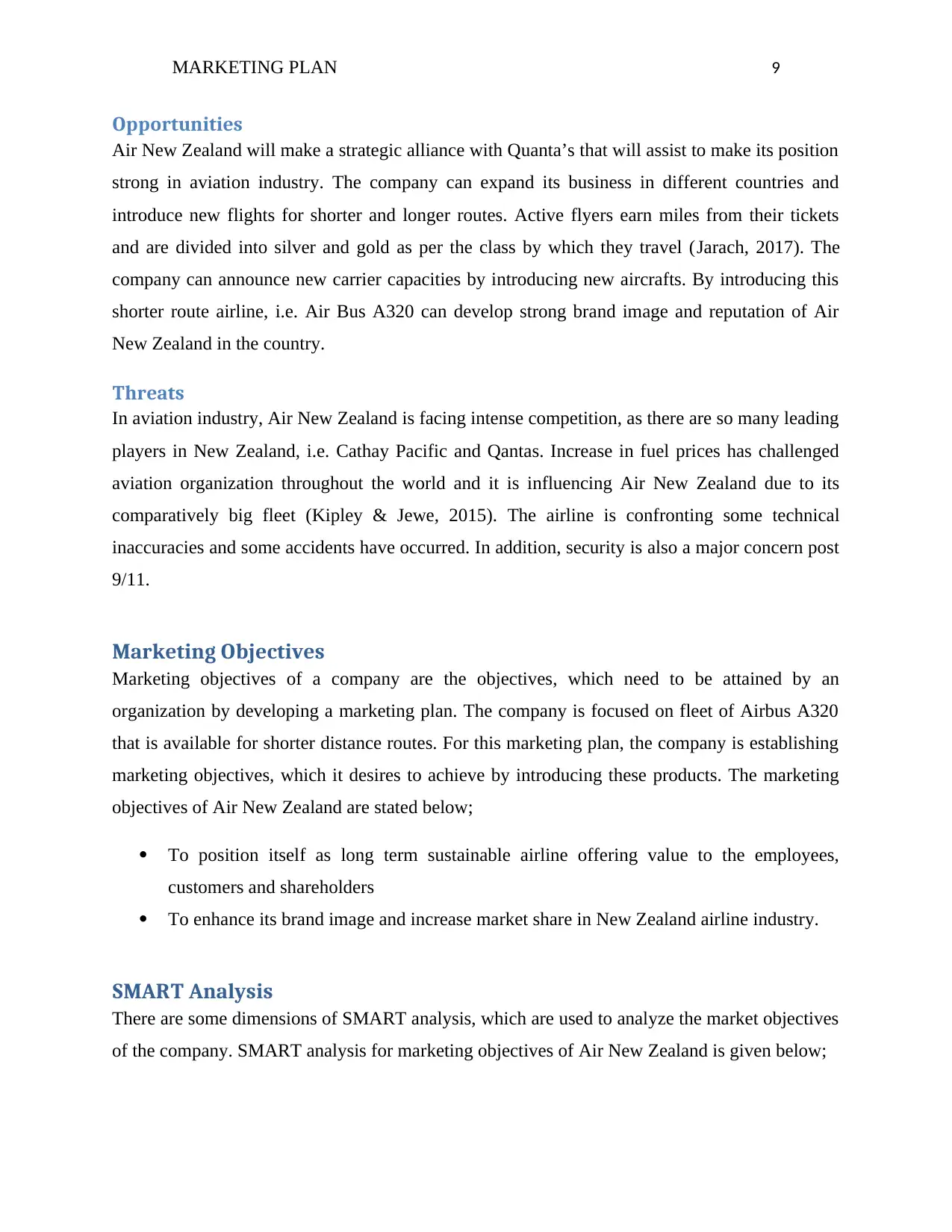
MARKETING PLAN 9
Opportunities
Air New Zealand will make a strategic alliance with Quanta’s that will assist to make its position
strong in aviation industry. The company can expand its business in different countries and
introduce new flights for shorter and longer routes. Active flyers earn miles from their tickets
and are divided into silver and gold as per the class by which they travel (Jarach, 2017). The
company can announce new carrier capacities by introducing new aircrafts. By introducing this
shorter route airline, i.e. Air Bus A320 can develop strong brand image and reputation of Air
New Zealand in the country.
Threats
In aviation industry, Air New Zealand is facing intense competition, as there are so many leading
players in New Zealand, i.e. Cathay Pacific and Qantas. Increase in fuel prices has challenged
aviation organization throughout the world and it is influencing Air New Zealand due to its
comparatively big fleet (Kipley & Jewe, 2015). The airline is confronting some technical
inaccuracies and some accidents have occurred. In addition, security is also a major concern post
9/11.
Marketing Objectives
Marketing objectives of a company are the objectives, which need to be attained by an
organization by developing a marketing plan. The company is focused on fleet of Airbus A320
that is available for shorter distance routes. For this marketing plan, the company is establishing
marketing objectives, which it desires to achieve by introducing these products. The marketing
objectives of Air New Zealand are stated below;
To position itself as long term sustainable airline offering value to the employees,
customers and shareholders
To enhance its brand image and increase market share in New Zealand airline industry.
SMART Analysis
There are some dimensions of SMART analysis, which are used to analyze the market objectives
of the company. SMART analysis for marketing objectives of Air New Zealand is given below;
Opportunities
Air New Zealand will make a strategic alliance with Quanta’s that will assist to make its position
strong in aviation industry. The company can expand its business in different countries and
introduce new flights for shorter and longer routes. Active flyers earn miles from their tickets
and are divided into silver and gold as per the class by which they travel (Jarach, 2017). The
company can announce new carrier capacities by introducing new aircrafts. By introducing this
shorter route airline, i.e. Air Bus A320 can develop strong brand image and reputation of Air
New Zealand in the country.
Threats
In aviation industry, Air New Zealand is facing intense competition, as there are so many leading
players in New Zealand, i.e. Cathay Pacific and Qantas. Increase in fuel prices has challenged
aviation organization throughout the world and it is influencing Air New Zealand due to its
comparatively big fleet (Kipley & Jewe, 2015). The airline is confronting some technical
inaccuracies and some accidents have occurred. In addition, security is also a major concern post
9/11.
Marketing Objectives
Marketing objectives of a company are the objectives, which need to be attained by an
organization by developing a marketing plan. The company is focused on fleet of Airbus A320
that is available for shorter distance routes. For this marketing plan, the company is establishing
marketing objectives, which it desires to achieve by introducing these products. The marketing
objectives of Air New Zealand are stated below;
To position itself as long term sustainable airline offering value to the employees,
customers and shareholders
To enhance its brand image and increase market share in New Zealand airline industry.
SMART Analysis
There are some dimensions of SMART analysis, which are used to analyze the market objectives
of the company. SMART analysis for marketing objectives of Air New Zealand is given below;
⊘ This is a preview!⊘
Do you want full access?
Subscribe today to unlock all pages.

Trusted by 1+ million students worldwide
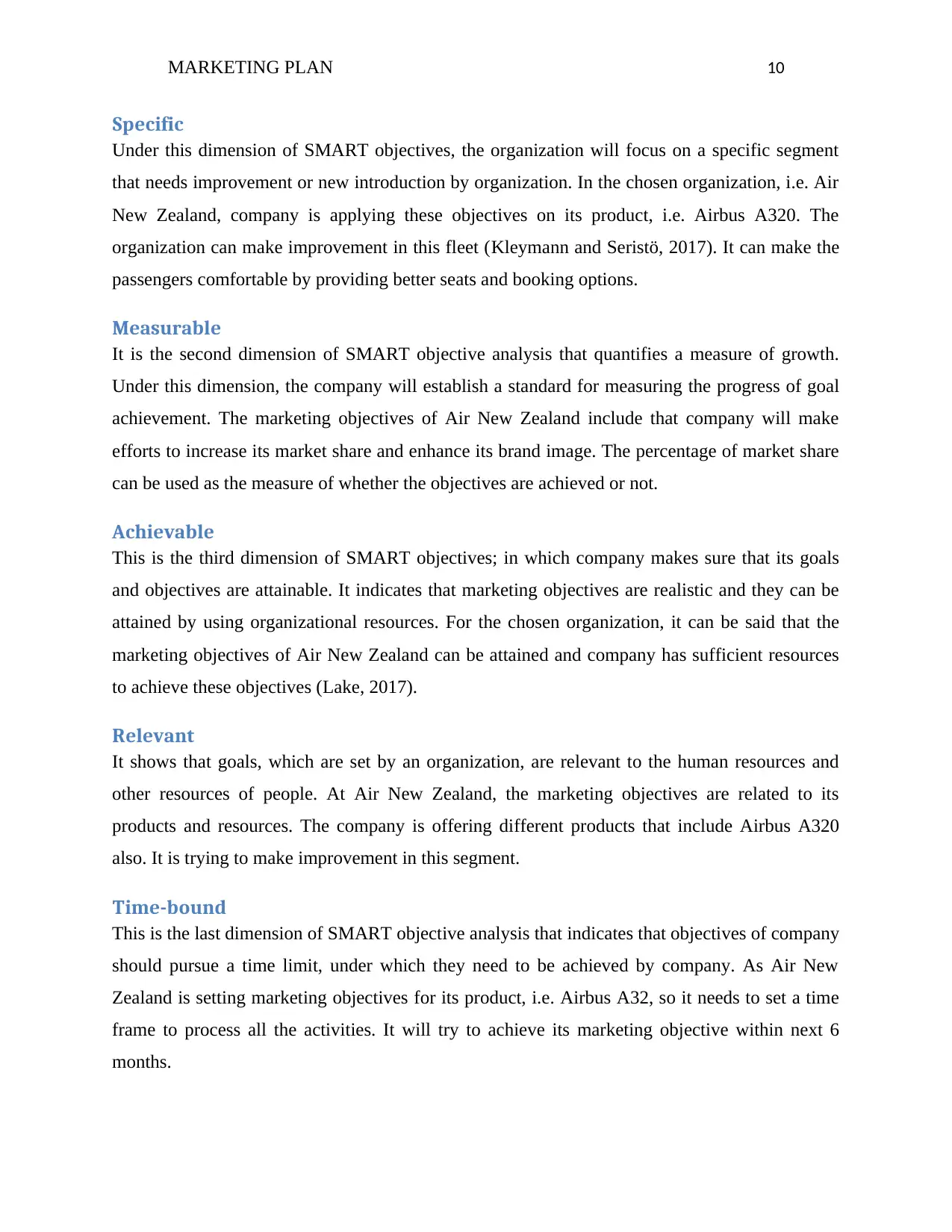
MARKETING PLAN 10
Specific
Under this dimension of SMART objectives, the organization will focus on a specific segment
that needs improvement or new introduction by organization. In the chosen organization, i.e. Air
New Zealand, company is applying these objectives on its product, i.e. Airbus A320. The
organization can make improvement in this fleet (Kleymann and Seristö, 2017). It can make the
passengers comfortable by providing better seats and booking options.
Measurable
It is the second dimension of SMART objective analysis that quantifies a measure of growth.
Under this dimension, the company will establish a standard for measuring the progress of goal
achievement. The marketing objectives of Air New Zealand include that company will make
efforts to increase its market share and enhance its brand image. The percentage of market share
can be used as the measure of whether the objectives are achieved or not.
Achievable
This is the third dimension of SMART objectives; in which company makes sure that its goals
and objectives are attainable. It indicates that marketing objectives are realistic and they can be
attained by using organizational resources. For the chosen organization, it can be said that the
marketing objectives of Air New Zealand can be attained and company has sufficient resources
to achieve these objectives (Lake, 2017).
Relevant
It shows that goals, which are set by an organization, are relevant to the human resources and
other resources of people. At Air New Zealand, the marketing objectives are related to its
products and resources. The company is offering different products that include Airbus A320
also. It is trying to make improvement in this segment.
Time-bound
This is the last dimension of SMART objective analysis that indicates that objectives of company
should pursue a time limit, under which they need to be achieved by company. As Air New
Zealand is setting marketing objectives for its product, i.e. Airbus A32, so it needs to set a time
frame to process all the activities. It will try to achieve its marketing objective within next 6
months.
Specific
Under this dimension of SMART objectives, the organization will focus on a specific segment
that needs improvement or new introduction by organization. In the chosen organization, i.e. Air
New Zealand, company is applying these objectives on its product, i.e. Airbus A320. The
organization can make improvement in this fleet (Kleymann and Seristö, 2017). It can make the
passengers comfortable by providing better seats and booking options.
Measurable
It is the second dimension of SMART objective analysis that quantifies a measure of growth.
Under this dimension, the company will establish a standard for measuring the progress of goal
achievement. The marketing objectives of Air New Zealand include that company will make
efforts to increase its market share and enhance its brand image. The percentage of market share
can be used as the measure of whether the objectives are achieved or not.
Achievable
This is the third dimension of SMART objectives; in which company makes sure that its goals
and objectives are attainable. It indicates that marketing objectives are realistic and they can be
attained by using organizational resources. For the chosen organization, it can be said that the
marketing objectives of Air New Zealand can be attained and company has sufficient resources
to achieve these objectives (Lake, 2017).
Relevant
It shows that goals, which are set by an organization, are relevant to the human resources and
other resources of people. At Air New Zealand, the marketing objectives are related to its
products and resources. The company is offering different products that include Airbus A320
also. It is trying to make improvement in this segment.
Time-bound
This is the last dimension of SMART objective analysis that indicates that objectives of company
should pursue a time limit, under which they need to be achieved by company. As Air New
Zealand is setting marketing objectives for its product, i.e. Airbus A32, so it needs to set a time
frame to process all the activities. It will try to achieve its marketing objective within next 6
months.
Paraphrase This Document
Need a fresh take? Get an instant paraphrase of this document with our AI Paraphraser
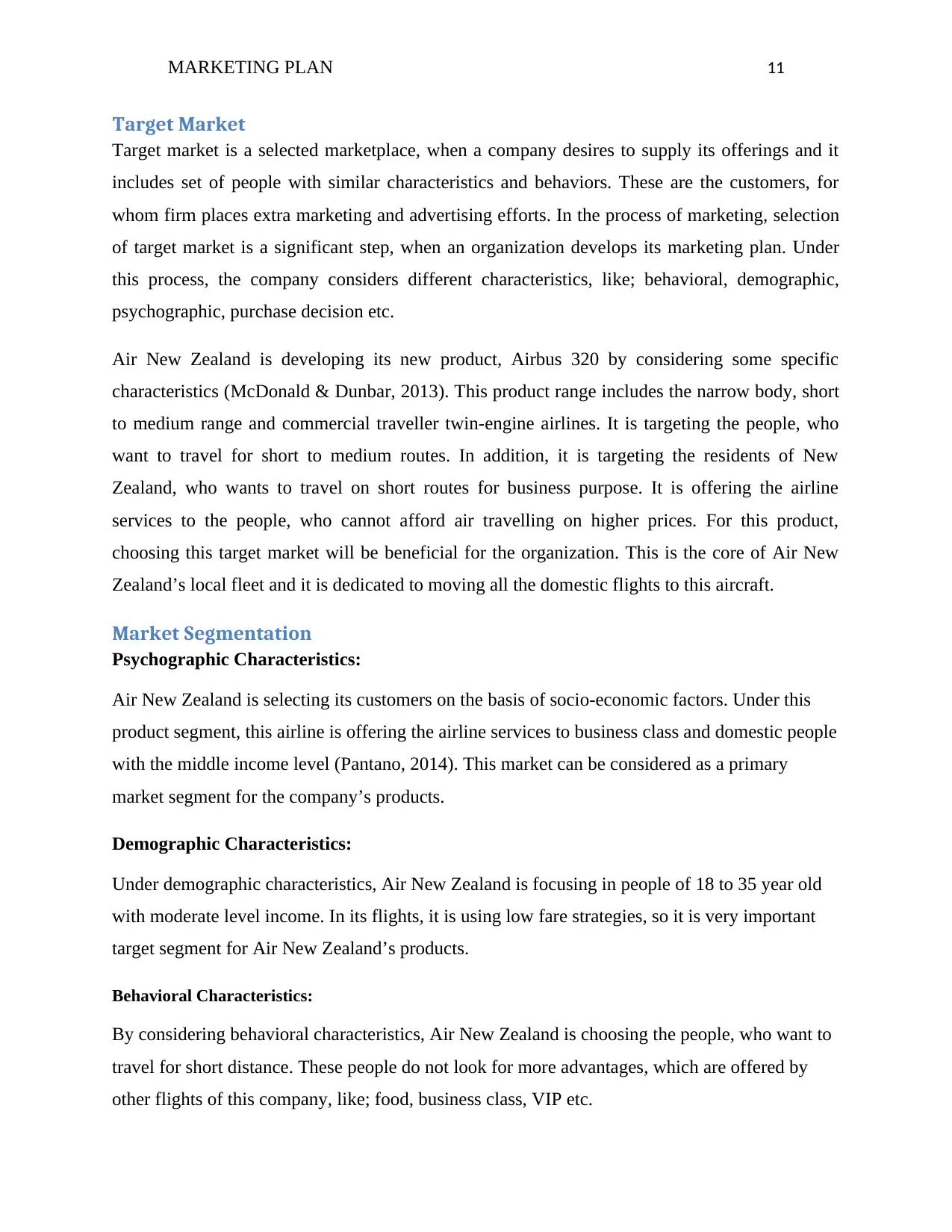
MARKETING PLAN 11
Target Market
Target market is a selected marketplace, when a company desires to supply its offerings and it
includes set of people with similar characteristics and behaviors. These are the customers, for
whom firm places extra marketing and advertising efforts. In the process of marketing, selection
of target market is a significant step, when an organization develops its marketing plan. Under
this process, the company considers different characteristics, like; behavioral, demographic,
psychographic, purchase decision etc.
Air New Zealand is developing its new product, Airbus 320 by considering some specific
characteristics (McDonald & Dunbar, 2013). This product range includes the narrow body, short
to medium range and commercial traveller twin-engine airlines. It is targeting the people, who
want to travel for short to medium routes. In addition, it is targeting the residents of New
Zealand, who wants to travel on short routes for business purpose. It is offering the airline
services to the people, who cannot afford air travelling on higher prices. For this product,
choosing this target market will be beneficial for the organization. This is the core of Air New
Zealand’s local fleet and it is dedicated to moving all the domestic flights to this aircraft.
Market Segmentation
Psychographic Characteristics:
Air New Zealand is selecting its customers on the basis of socio-economic factors. Under this
product segment, this airline is offering the airline services to business class and domestic people
with the middle income level (Pantano, 2014). This market can be considered as a primary
market segment for the company’s products.
Demographic Characteristics:
Under demographic characteristics, Air New Zealand is focusing in people of 18 to 35 year old
with moderate level income. In its flights, it is using low fare strategies, so it is very important
target segment for Air New Zealand’s products.
Behavioral Characteristics:
By considering behavioral characteristics, Air New Zealand is choosing the people, who want to
travel for short distance. These people do not look for more advantages, which are offered by
other flights of this company, like; food, business class, VIP etc.
Target Market
Target market is a selected marketplace, when a company desires to supply its offerings and it
includes set of people with similar characteristics and behaviors. These are the customers, for
whom firm places extra marketing and advertising efforts. In the process of marketing, selection
of target market is a significant step, when an organization develops its marketing plan. Under
this process, the company considers different characteristics, like; behavioral, demographic,
psychographic, purchase decision etc.
Air New Zealand is developing its new product, Airbus 320 by considering some specific
characteristics (McDonald & Dunbar, 2013). This product range includes the narrow body, short
to medium range and commercial traveller twin-engine airlines. It is targeting the people, who
want to travel for short to medium routes. In addition, it is targeting the residents of New
Zealand, who wants to travel on short routes for business purpose. It is offering the airline
services to the people, who cannot afford air travelling on higher prices. For this product,
choosing this target market will be beneficial for the organization. This is the core of Air New
Zealand’s local fleet and it is dedicated to moving all the domestic flights to this aircraft.
Market Segmentation
Psychographic Characteristics:
Air New Zealand is selecting its customers on the basis of socio-economic factors. Under this
product segment, this airline is offering the airline services to business class and domestic people
with the middle income level (Pantano, 2014). This market can be considered as a primary
market segment for the company’s products.
Demographic Characteristics:
Under demographic characteristics, Air New Zealand is focusing in people of 18 to 35 year old
with moderate level income. In its flights, it is using low fare strategies, so it is very important
target segment for Air New Zealand’s products.
Behavioral Characteristics:
By considering behavioral characteristics, Air New Zealand is choosing the people, who want to
travel for short distance. These people do not look for more advantages, which are offered by
other flights of this company, like; food, business class, VIP etc.
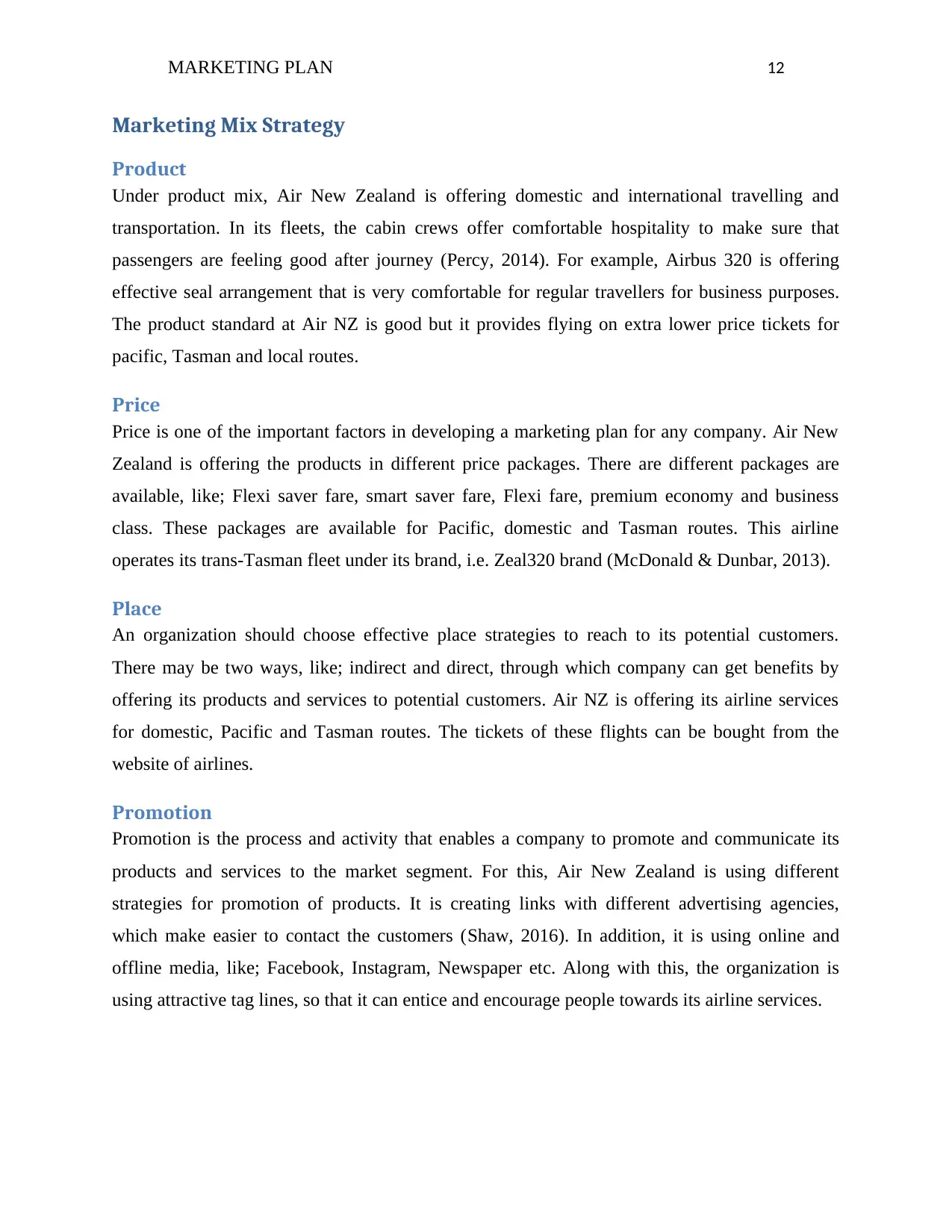
MARKETING PLAN 12
Marketing Mix Strategy
Product
Under product mix, Air New Zealand is offering domestic and international travelling and
transportation. In its fleets, the cabin crews offer comfortable hospitality to make sure that
passengers are feeling good after journey (Percy, 2014). For example, Airbus 320 is offering
effective seal arrangement that is very comfortable for regular travellers for business purposes.
The product standard at Air NZ is good but it provides flying on extra lower price tickets for
pacific, Tasman and local routes.
Price
Price is one of the important factors in developing a marketing plan for any company. Air New
Zealand is offering the products in different price packages. There are different packages are
available, like; Flexi saver fare, smart saver fare, Flexi fare, premium economy and business
class. These packages are available for Pacific, domestic and Tasman routes. This airline
operates its trans-Tasman fleet under its brand, i.e. Zeal320 brand (McDonald & Dunbar, 2013).
Place
An organization should choose effective place strategies to reach to its potential customers.
There may be two ways, like; indirect and direct, through which company can get benefits by
offering its products and services to potential customers. Air NZ is offering its airline services
for domestic, Pacific and Tasman routes. The tickets of these flights can be bought from the
website of airlines.
Promotion
Promotion is the process and activity that enables a company to promote and communicate its
products and services to the market segment. For this, Air New Zealand is using different
strategies for promotion of products. It is creating links with different advertising agencies,
which make easier to contact the customers (Shaw, 2016). In addition, it is using online and
offline media, like; Facebook, Instagram, Newspaper etc. Along with this, the organization is
using attractive tag lines, so that it can entice and encourage people towards its airline services.
Marketing Mix Strategy
Product
Under product mix, Air New Zealand is offering domestic and international travelling and
transportation. In its fleets, the cabin crews offer comfortable hospitality to make sure that
passengers are feeling good after journey (Percy, 2014). For example, Airbus 320 is offering
effective seal arrangement that is very comfortable for regular travellers for business purposes.
The product standard at Air NZ is good but it provides flying on extra lower price tickets for
pacific, Tasman and local routes.
Price
Price is one of the important factors in developing a marketing plan for any company. Air New
Zealand is offering the products in different price packages. There are different packages are
available, like; Flexi saver fare, smart saver fare, Flexi fare, premium economy and business
class. These packages are available for Pacific, domestic and Tasman routes. This airline
operates its trans-Tasman fleet under its brand, i.e. Zeal320 brand (McDonald & Dunbar, 2013).
Place
An organization should choose effective place strategies to reach to its potential customers.
There may be two ways, like; indirect and direct, through which company can get benefits by
offering its products and services to potential customers. Air NZ is offering its airline services
for domestic, Pacific and Tasman routes. The tickets of these flights can be bought from the
website of airlines.
Promotion
Promotion is the process and activity that enables a company to promote and communicate its
products and services to the market segment. For this, Air New Zealand is using different
strategies for promotion of products. It is creating links with different advertising agencies,
which make easier to contact the customers (Shaw, 2016). In addition, it is using online and
offline media, like; Facebook, Instagram, Newspaper etc. Along with this, the organization is
using attractive tag lines, so that it can entice and encourage people towards its airline services.
⊘ This is a preview!⊘
Do you want full access?
Subscribe today to unlock all pages.

Trusted by 1+ million students worldwide
1 out of 17
Related Documents
Your All-in-One AI-Powered Toolkit for Academic Success.
+13062052269
info@desklib.com
Available 24*7 on WhatsApp / Email
![[object Object]](/_next/static/media/star-bottom.7253800d.svg)
Unlock your academic potential
Copyright © 2020–2025 A2Z Services. All Rights Reserved. Developed and managed by ZUCOL.





